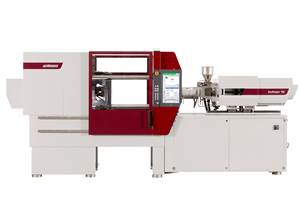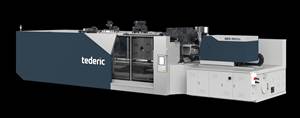Outrunning the Competition with the First Plastic 2-Stroke Engine Valves
All it took was some original ideas, a lot of nerve, and a little high-tech injection molding.
The wind whispering in the pines of rural New Hampshire. The high-pitched whine of a high-performance motorcycle engine. The near silence of all-electric injection machines molding plastic parts. These form the ambience at a low-slung industrial building next to a tiny regional airport in West Lebanon, N.H., where two brothers with no formal technical training created a world-leading business in a very technical niche related to their love of motorcycle racing.
Twenty-one years ago, Steve and Scott Tassinari, who grew up in nearby Hartford, Vt. (also known as White River Junction), came up with a better design for a reed valve, which controls the fuel/air mixture to the engine’s cylinders. Today, their company, Moto Tassinari (mototassinari.com), is the leading global producer of reed valves and other parts, such as intake manifolds, for the two-stroke engine aftermarket, which includes motor scooters, motorcycles (including racing and off-road motocross types), all-terrain vehicles (ATVs), and snowmobiles.
Their firm employs 13 and sells around 160,000 valves a year, bringing in close to $5 million. Key customers include Polaris, Artic Cat, Ski-Doo, Husqvarna, KTM in Austria (Europe’s leading motorcycle manufacturer), and many others. Its aftermarket valves are designed for use in Honda, Kawasaki, Suzuki, and Yamaha motorbikes and scooters. In no small part, their success is owed to their pioneering the use of plastics in these parts.
GOING OUT ON THEIR OWN
Steve Tassinari, the older of the two brothers, is the creative technical brains behind their independent venture. While working as a mechanic on the Suzuki motocross racing team, he came up with the idea for a better reed valve. He tried out his design on his own bikes and saw better engine timing, higher horsepower, and better acceleration. “That—combined with rider skills—is pretty much everything you need to get an edge in racing,” he says.
The two brothers, neither of whom went to college, started out in 1990 building racing engines for motorcycles. In 1995, they decided to focus on Steve’s new design for reed valves. While existing valves were—and still are—cast in aluminum, the Tassinaris machined them five at a time out of aluminum billet. “Our first focus was on snowmobiles. We sold 1100 of those valves the first year, but we didn’t make any money,” says Scott, who is the business manager for the firm. “The process was very expensive, and we used an outside assembly house and had quality issues.”
After working long hours trying to perfect their design, the brothers switched from aluminum to plastic valves the next year. “No one had ever done it before,” Steve says. “We were inexperienced in plastic design, and that was compounded by problems in manufacturing.” They learned to eliminate screws, which failed in use, replacing them with snap fits. Like typical aluminum valves, they overmolded rubber onto their new plastic valves but suffered delamination problems and once again had to switch vendors. “We sold a lot of those valves—over $600,000 worth—and had to make good on all of them after they failed,” Scott recalls. “The snowmobile industry loved our designs and saw better performance, but the parts wouldn’t last. We decided to go back to the drawing board to create a product that would work and survive the harsh environment of a two-cycle engine.”
They came back with a new design, the V-Force 2, and performance was vastly improved. Then, in 2003, eight years after starting the company, the next-generation valve was introduced, the V-Force 3. This time, their patented design worked great and sales took off. “We couldn’t make these fast enough,” says Scott. “This valve requires no maintenance and is ready to go to market right off the molding machine.” The V-Force 3 has been selling since 2003, though there is now also a V-Force 4 model.
The newest models are injection molded of Solvay’s 45% glass-filled Amodel PPA, a high-temperature polyamide cousin of standard nylons that provides the necessary stiffness and heat and chemical resistance, Steve explains. Some non-critical parts like air guides are also molded of 33% glass-filled nylon 66. A typical valve consists of five molded parts plus four thin “petals”—the moving part of the valve, which flutter open and closed 166 times a second at 10,000 rpm. The petals are machined out of fiberglass or carbon-fiber/epoxy composite sheet. The entire valve snaps together, and the petals can be replaced when worn without tools, using snap fits—another patented feature.
GETTING INTO MOLDING
After proving that they could make a better and most cost-effective reed valve out of plastic rather than aluminum, the Tassinaris realized that they preferred to control production of their own parts. “It can take a lot of time to go outside and get samples made,” says Scott. “We didn’t know a thing about molding, but we decided to bring in our own machines and operators so we had complete control of our manufacturing under one roof.”
Moto Tassinari bought the molding operations of a company that was moving out of Lebanon. That firm had three older machines; since the Tassinaris already planned to move to a new, larger building and upgrade their facility, they decided to replace the older machines with new models. They looked at numerous brands but decided on Wittmann Battenfeld, Inc. for several reasons, including familiarity—two of their older presses were Battenfelds, and the operators knew how to run them and enjoyed their ease of use. The Tassinaris also paid a visit to Wittmann Battenfeld’s U.S. headquarters in Torrington, Conn., and came away impressed. “We really like the support that Wittmann Battenfeld provides,” says Scott. “We get great service from our rep, Emmett Reardon, who has bent over backwards to make us happy. And Markus Klaus [USA division manager for injection machines] and his team at Wittmann Battenfeld are always ready to come up to our plant to make sure our machines are working at optimal efficiency.”
Last November, Moto Tassinari bought three new Wittmann Battenfeld EcoPower all-electric machines, two 110-tonners and one 55-ton press, for the new 14,000-ft2, air-conditioned plant. The press operator, Mark Symonds, who came from the acquired custom molder, likes the quietness of the electric machines. “The old facility was noisy,” he recalls, unlike the current plant, where the only sound on the molding floor is the parts dropping into bins. Besides being quiet, Symonds notes that the electric machines are “clean and remember settings. And if we hook them up to the internet, Wittmann Battenfeld can see what we’re doing if we have a problem and can even change settings for us remotely.”
Moto Tassinari also retains one of the old hydraulic Battenfeld 110’s. “It still works great,” notes Steve Tassinari.
The plant’s auxiliary equipment includes dryers, a hot-water mold-temperature controller, and one Wittmann chiller. “When we need more auxiliary equipment, we will go to Wittmann,” says Scott. Someday, that might include robots: “I only hope we get so busy that we need some automation.”
One possible use of robotics might be in overmolding copolyester TPE seals onto PPA valve bodies, or “cages.” These are hand-loaded at present. Some models, including a new one being developed for KTM and two other European motorcycle makers, are overmolded with thermoset rubber, which is done by an outside vendor.
Moto Tassinari’s molds are all built by a local vendor, Ken Robbins, who works from his home machine shop. “We’re his only customer,” says Steve. “Our tools have lots of undercuts and side actions, including thin slides that interlock in a dovetail arrangement.” The parts have relatively thin walls, from 20 to 150 mils. Moto Tassinari employs an engineer who translates Steve’s concepts into finished designs. “We tried using a consultant for flow analysis once,” Steve says. “They told us our parts couldn’t be molded.”
The new plant has a development lab with a complete motorcycle and a computer-controlled dynamometer to test engine function. “We develop programmed tests for each component,” Steve notes.
“We also test new designs with actual riders on bikes.” The brothers spent over $300,000 on the
testing setup.
“We were the first in the world with plastic reed valves, which are patented,” says Scott. “People try to copy us, but they haven’t been able to match our performance, durability, and cost.” More than half the firm’s business is domestic, and 65% of it is aftermarket. A whole new market possibility for Moto Tassinari is four-cycle racing motorcycle engines, which have been pushed in recent years by the bike manufacturers. “Those engines don’t use reed valves now, but they would get better performance with them,” Steve asserts.
Related Content
Completely Connected Molding
NPE2024: Medical, inmold labeling, core-back molding and Industry 4.0 technologies on display at Shibaura’s booth.
Read MoreFakuma 2023: Wittmann Battenfeld Expands All-Electric Line, Direct-Current Capabilities
Wittmann Battenfeld will introduce the new EcoPower B8X injection molding machine line and show direct current as an energy source for a concept machine that will power its own robot.
Read MoreTederic Promotes High Technology, Broader Market Presence
Four cells are running in its booth including a 1,300-ton multimaterial system highlighting its 2K capabilities.
Read MoreCoinjection Technology Showcases Recycled Material Containment
At Fakuma, an all-electric PXZ Multinject machine sandwiches a black core made of mechanically recycled PC/ABS within an outer layer made of chemically recycled ABS.
Read MoreRead Next
Making the Circular Economy a Reality
Driven by brand owner demands and new worldwide legislation, the entire supply chain is working toward the shift to circularity, with some evidence the circular economy has already begun.
Read MoreBeyond Prototypes: 8 Ways the Plastics Industry Is Using 3D Printing
Plastics processors are finding applications for 3D printing around the plant and across the supply chain. Here are 8 examples to look for at NPE2024.
Read MoreFor PLASTICS' CEO Seaholm, NPE to Shine Light on Sustainability Successes
With advocacy, communication and sustainability as three main pillars, Seaholm leads a trade association to NPE that ‘is more active today than we have ever been.’
Read More






















